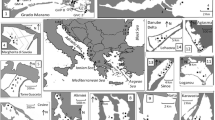Abstract
Energy equivalence assumes equal contribution of large and small species to production and energy flow in communities. As in a double logarithmic plot, physiological rates decline with body weight by −0.25, log biomass should increase by 0.25 and log abundance decline by −0.75 with log species weight, when this concept is valid. This was tested with annual data sets of the macrobenthos of 4 intertidal sites in the German Wadden Sea (Königshafen) and 3 sites in a south Portuguese lagoon (Ria Formosa). Only abundance data from two of these sites displayed significantly negative slopes with mean body size of the species. Biomass and secondary production data were significantly positively correlated with mean body size for all Ria Formosa sites and also for the biomass of a mussel bed in Königshafen. However, high variation in body size of the individuals of a species limits interpretation of these plots.
It is preferable to test this concept by body weight classes regardless of its species composition. At Königshafen, biomass and production displayed two distinct peaks. One peak at small body size was caused by browsing species. The other peak at larger body size was caused by animals which potentially extract their food from the water column. This bimodality was only vaguely reflected at one station in the Ria Formosa, possibly because of a dominance of detritus feeding species. In a normalized form (log biomass or production / width of size classvs. log size class), these spectra imply a dominance of small individuals in biomass and production at all sites (except for a mussel bank at Königshafen). This is interpreted as a consequence of permanent disturbances.
Similar content being viewed by others
References
ASMUS, H., 1994. Benthic grazers and suspension feeders: which one assumes the energetic dominance in Königshafen? Helgoländer Meeresunters., 48: 217–231.
ASMUS, H. and R. ASMUS, 1985. The importance of grazing food chain for energy flow and production in three intertidal sand bottom communities of the northern Wadden Sea. Helgoländer Meeresunters., 39: 273–301.
BANSE, K. and S. MOSHER, 1980. Adult body mass and annual production/biomass relationships of field populations. Ecol. Monogr., 50: 355–379.
BLACKBURN, T.M., V.K. BROWN, B.M. DOUBE, J.D. GREENWOOD, J.H. LAWTON and N.E. STORK, 1993. The relationship between abundance and body size in natural animal assemblages. J. Anim. Ecol., 62: 519–528.
BORGMANN, U., 1987. Models of the slope of, and biomass flow up, the biomass size spectrum. Can. J. Fish. Aquat. Sci., 44 (suppl. 2): 136–140.
DAMUTH, J., 1987. Interspecific allometry of population density in mammals and other animals: the independence of body mass and population energy use. Biol. J. Linn. Soc., 31: 193–246.
DAMUTH, J., 1991. Of size and abundance. Nature, 351: 268–269.
EDGAR, G.J., 1994. Observations on the size structure of macrofaunal assemblages. J. Exp. Mar. Biol. Ecol., 176: 227–243.
GAEDKE, U., 1993. Ecosystem analysis based on biomass size distributions: a case study of a plankton community in a large lake. Limnol. Oceanogr., 38: 112–127.
GEE, J.M. and R.M. WARWICK, 1994. Metazoan community structure in relation to the fractal dimensions of marine macroalgae. Mar. Ecol. Prog. Ser., 103: 141–150.
GERLACH, S.A., A.E. HAHN and M. SCHRAGE, 1985. Size spectra of benthic biomass and metabolism. Mar. Ecol. Prog. Ser., 26: 161–173.
GRIFFITHS, D., 1992. Size, abundance, and energy use in communities. J. Anim. Ecol., 61: 307–315.
HANSON, J.M., E.E. PREPAS and W.C. MACKAY, 1989. Size distribution of the macroinvertebrate community in a freshwater lake. Can. J. Fish. Aquat. Sci., 46: 1510–1519.
HEMMINGSEN, A.M., 1960. Energy metabolism as related to body size and respiratory surfaces, and its evolution. Rep. Steno meml. Hosp., 9: 1–110.
KRÜGER, F., 1977. Bau und Leben des WattwurmesArenicola marina. — Helgoländer wiss. Meeresunter., 22 (revised reprint).
NORDSIECK, F., 1982. Die europäischen Meeres-Gehäuseschnecken (Prosobranchia). 2nd ed. Fischer, Stuttgart.
REISE, K., 1985. Tidal flat ecology — an experimental approach to species interactions. Springer, Berlin.
SCHWINGHAMER, P., 1981. Characteristic size distributions of integral benthic communities. Can. J. Fish. Aquat. Sci., 38: 1255–1263.
SHELDON, R.W., A. PRAKASH and W.H. SUTCLIFFE, Jr., 1972. The size distribution of particles in the ocean. Limnol. Oceanogr., 17: 327–340.
SPRULES, W.G. and M. MUNAWAR, 1986. Plankton size spectra in relation to ecosystem productivity, size, and pertubation. Can. J. Fish. Aquat. Sci., 43: 1789–1794.
SPRUNG, M., 1993. Estimating macrobenthic secondary production from body weight and biomass: a field test in a non-boreal intertidal habitat. Mar. Ecol. Prog. Ser., 100: 103–109.
SPRUNG, M., 1994. Macrobenthic secondary production in the intertidal zone of the Ria Formosa — a lagoon in Southern Portugal. Estuar. Coast. Shelf. Sci., 38: 539–558.
VALIELA, I., J.M. TEAL, S.D. ALLEN, R. VAN ETTEN, D. GOEHRINGER and S. VOLKMANN, 1985. Decomposition in salt marsh ecosystems: the phases and major factors affecting disappearance of above-ground organic matter. J. Exp. Mar. Biol. Ecol., 89: 29–54.
Author information
Authors and Affiliations
Rights and permissions
About this article
Cite this article
Sprung, M., Asmus, H. Does the energy equivalence rule apply to intertidal macrobenthic communities?. Netherlands Journal of Aquatic Ecology 29, 369–376 (1995). https://doi.org/10.1007/BF02084236
Issue Date:
DOI: https://doi.org/10.1007/BF02084236




